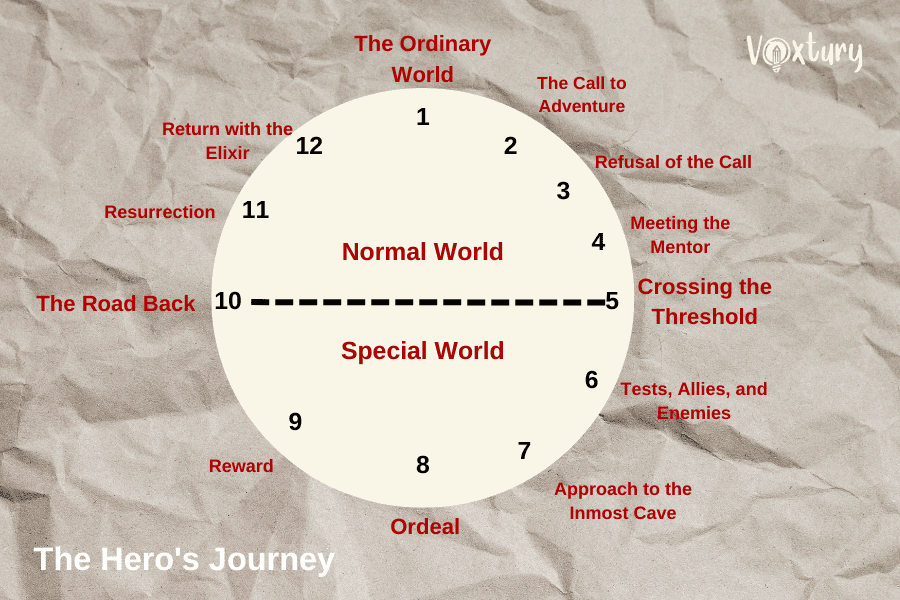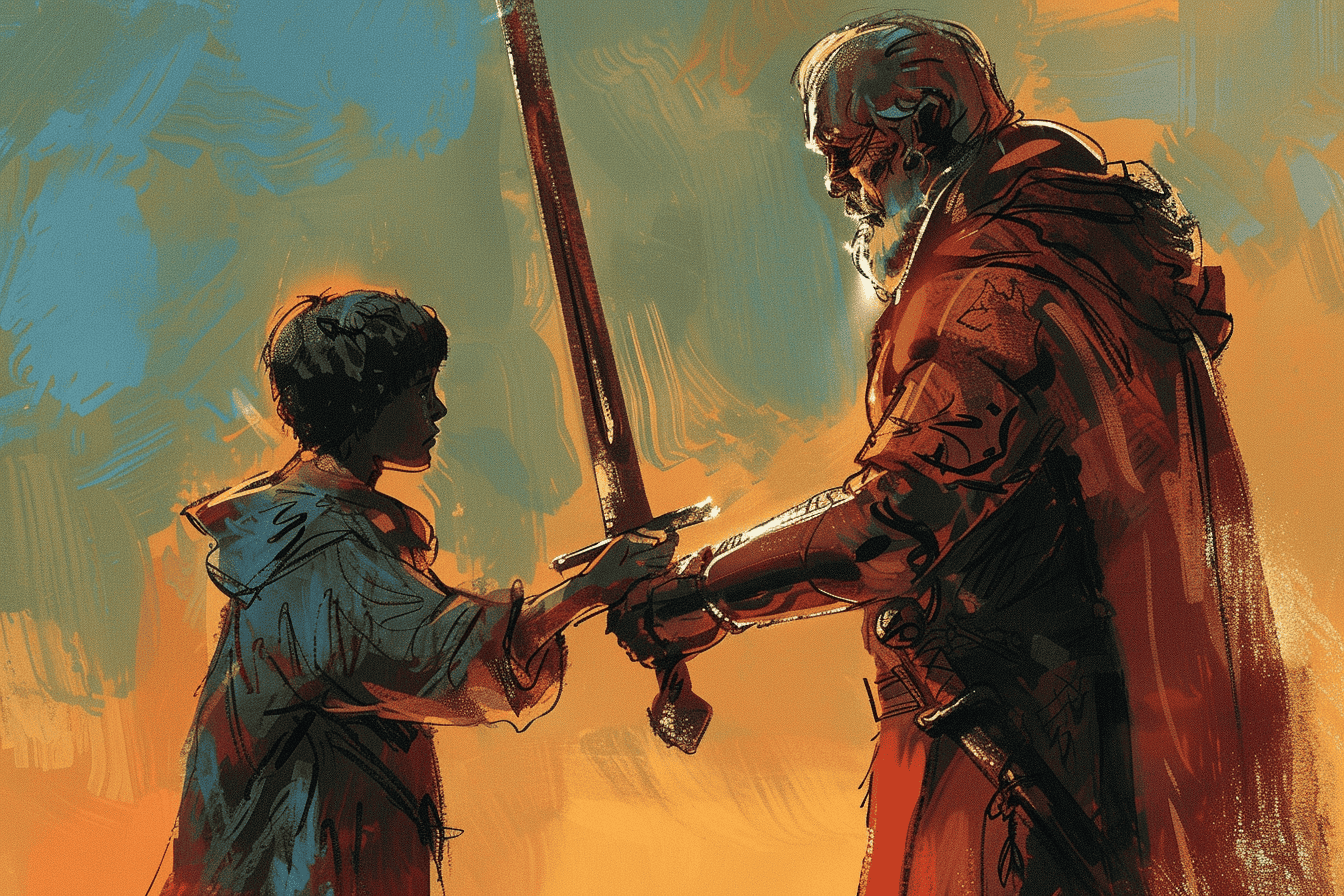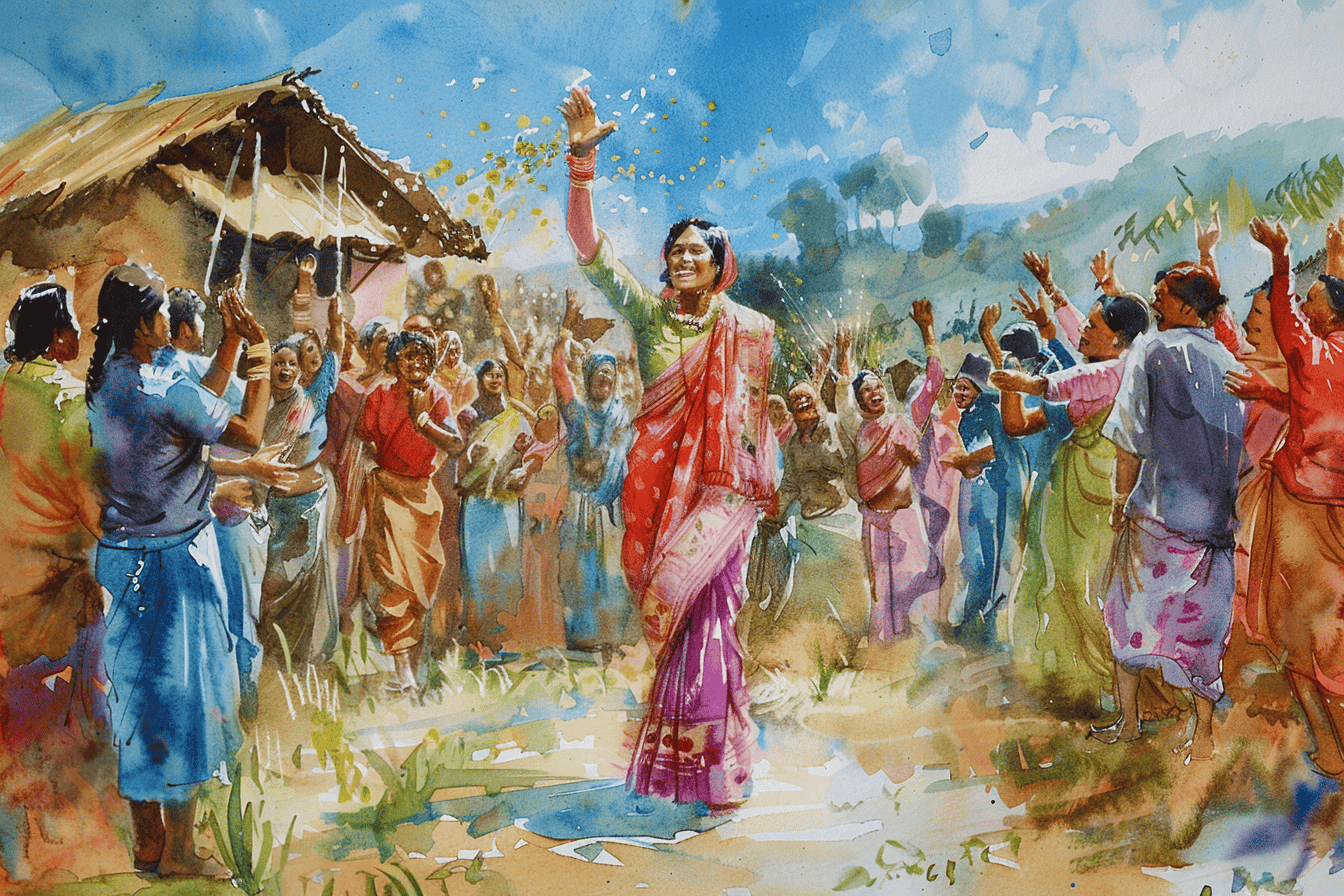The Hero’s Journey, a narrative structure popularized by Joseph Campbell, outlines a universal pattern that many stories follow. It consists of three main stages: Departure, Initiation, and Return.
In this comprehensive guide, we will take a closer look at The Hero’s Journey, explaining:
- How this structure works + examples
- Tips on how to use it to your full advantage
- And if you need it all
What Is the Hero’s Journey in Storytelling?
The Hero’s Journey is a common narrative structure found in stories across cultures and time periods. It follows a basic pattern where a protagonist, often ordinary at first, embarks on an adventure, faces challenges, learns valuable lessons, and returns home transformed.
Here’s a breakdown of the key stages:
Departure
- The Ordinary World: The hero lives a normal life, unaware of the adventure to come.
- The Call to Adventure: An event disrupts the hero’s ordinary life, prompting them to embark on a journey.
- Refusal of the Call: The hero may initially hesitate or resist the call due to fear or uncertainty.
- Meeting the Mentor: The hero encounters a wise figure who provides guidance and advice.
- Crossing the Threshold: The hero commits to the journey and leaves their familiar world behind.
Initiation
- Tests, Allies, and Enemies: The hero faces challenges, makes allies, and encounters adversaries.
- Approach to the Inmost Cave: The hero reaches a crucial point, often a dangerous or mysterious place.
- Ordeal: The hero undergoes a major test or crisis, often a life-or-death situation.
- Reward: The hero overcomes the ordeal and gains a valuable prize or insight.
Return
- The Road Back: The hero begins the journey home, often facing new challenges.
- Resurrection: The hero faces a final test, often a battle against a powerful enemy.
- Return with the Elixir: The hero returns to their ordinary world, transformed and bringing a gift or knowledge to benefit others.

The Hero’s Journey provides a powerful framework for crafting engaging stories that resonate with audiences. By wielding it well, you can create compelling narratives that take readers on unforgettable adventures.
Want to craft compelling stories?
Discover the power of these 7 popular plot structures and learn how to apply them to your own work. Read more in our blog post: Types of Story Structure – Exploring 7 Popular Plot Structures.
Breaking Down the 12 Hero’s Journey Stages
Let’s examine each of the stages and how they move the story forward. We’ll use a fairly simple example from the fantasy genre.
1. The Ordinary World
The first stage introduces the protagonist and their normal, everyday life, establishing a baseline for the extraordinary journey to come.
- A young farmhand, Elara, lives a simple life in a peaceful village.
2. The Call to Adventure
A disruption to the ordinary world, a catalyst that pulls the protagonist out of their comfort zone.
- A mysterious stranger arrives in the village, seeking a hero to defeat a dark sorcerer threatening the kingdom.
3. Refusal of the Call
This stage highlights the hero’s initial reluctance or fear, adding tension and internal conflict.
- Elara, fearing for her own safety and the safety of her family, initially declines the call.
4. Meeting the Mentor
The hero encounters a wise figure who provides guidance, training, and support, equipping them for the journey.
- A wise old hermit, a former knight, offers to train Elara in swordsmanship and magic.

5. Crossing the Threshold
The hero commits to the adventure, leaving behind their familiar world and entering a new, often dangerous realm.
- Elara leaves her village and embarks on a perilous journey into the unknown, venturing into a dark forest.
6. Tests, Allies, and Enemies
This stage introduces challenges, both physical and mental, that test the hero’s abilities. Allies provide support, while enemies create obstacles.
- Elara faces a series of trials, including battles with monstrous creatures, solving riddles, and navigating treacherous terrain. She forms alliances with a cunning rogue and a noble knight while battling a ruthless bandit and a cunning sorceress.
7. Approach to the Inmost Cave
The hero reaches a crucial point in the journey, often a dangerous or mysterious place, symbolizing the ultimate challenge.
- Elara reaches the sorcerer’s fortress, a dark and foreboding place filled with traps and dark magic.
8. Ordeal
The hero faces their greatest challenge, a life-or-death situation that tests their limits.
- Elara confronts the sorcerer in a climactic battle, risking her life to defeat him.
9. Reward
The hero overcomes the ordeal, gaining a valuable prize or insight, often a tangible object or spiritual knowledge.
- Elara emerges victorious, gaining the sorcerer’s magical artifact and the respect of the kingdom.
10. The Road Back
The hero begins the journey back home, facing new challenges and obstacles.
- Elara returns to her village, but the journey home is fraught with danger as the sorcerer’s remaining minions seek revenge.
11. Resurrection
The hero undergoes a final test, often a battle against a powerful enemy, symbolizing rebirth and transformation.
- Elara faces a final confrontation with a powerful demon summoned by the sorcerer’s remaining followers.
12. Return with the Elixir
The hero returns to their ordinary world transformed and brings a gift or knowledge to benefit others.
- Elara defeats the demon, saving her village and the kingdom. She returns home as a hero, bringing peace and prosperity to her people.
The appeal of the Hero’s Journey lies in its universal resonance and its ability to tap into deep-seated human desires and archetypes. In short, we love to see our heroes struggle through trials and tribulations before they achieve glory and wisdom.
The popularity of this structure in media can be explained by the fact that the Hero’s Journey structure allows for a well-defined emotional arc. It takes the reader on a rollercoaster of emotions, from hope and excitement to fear and despair, ultimately culminating in triumph.

Examples of Stories Using the Hero’s Journey
Let’s analyze examples of books and movies that exemplify this structure, along with an analysis of how each fits into the Hero’s Journey framework.
The Hunger Games by Suzanne Collins
- Departure: Katniss Everdeen lives in District 12 (Ordinary World) until she volunteers for her sister.
- Initiation: She trains for the Games, faces trials, and forms alliances with Peeta and others.
- Return: After winning, she returns home but is forever changed by her experiences.
Harry Potter and the Philosopher’s Stone by J.K. Rowling
- Departure: Harry lives with his neglectful relatives until he receives his acceptance letter to Hogwarts (Call to Adventure).
- Initiation: He learns about magic and faces various challenges alongside friends Ron and Hermione.
- Return: After defeating Voldemort in his first year, he returns home for the summer, changed by his experiences.
The Lion King (1994)
- Departure: Simba lives a carefree life until Mufasa’s death prompts him to flee (Refusal of Call).
- Initiation: He grows up in exile but learns about his past and responsibilities.
- Return: Simba returns to reclaim his throne from Scar, transforming into a leader.
These examples illustrate how diverse narratives can fit into the Hero’s Journey framework across various genres, from fantasy and dystopia to classic literature and animation. Each story resonates with audiences through its exploration of transformation and personal growth within familiar structural elements.
How to Use the Hero’s Journey in Storytelling
So, how can you elevate your storytelling with this structure?
Tweaking the Stages
While the classic structure is powerful, feel free to adapt it to suit your story. You might combine stages, skip some entirely, or introduce new ones.
For example, instead of a traditional mentor figure, you could have a series of mentors who each teach the hero a valuable lesson. Or, you could eliminate the “Refusal of the Call” stage if your hero is eager to embark on their journey from the start.
It’s your story, and if it doesn’t fit neatly into any given story structure, that’s more than okay!
Show, Don’t Tell
One of the most important rules of writing – rather than explicitly stating the hero’s growth, demonstrate it through their actions and choices.
Instead of telling us that the hero has become more courageous, show us how they overcame a difficult challenge that would have previously terrified them. Or, instead of telling us that the hero has learned to trust others, show us how they open up to a new ally and form a deep bond.
In the Hero’s Journey, It’s all about, well, the hero. So pay close attention to how you portray them and if your efforts yield exciting results.

Balance Action and Introspection
A well-rounded hero needs both external conflict and internal struggle. They can’t run straight into the face of danger without letting the audience know what’s truly at stake here. Alternate between action-packed scenes and quieter moments of reflection.
After a thrilling battle, the hero might take a moment to rest and contemplate the meaning of their journey. Or, during a quiet moment of introspection, the hero might have a flashback to a traumatic event from their past, revealing a hidden fear or insecurity.
Create High Stakes
This almost goes without saying. The hero’s journey should be filled with significant risks and consequences. What will the hero lose if they fail? What will they gain if they succeed?
These questions should accompany readers throughout the story. Remember – the low stakes make the hero’s adventures inconsequential. Make sure the central conflict of your book is logical, reasonable, and serious.
The Power of Transformation
The hero’s journey is not just about the destination but the transformation along the way. Show how the hero changes, both physically and emotionally.
For example, the hero might start out as a timid and insecure person, but through their trials and tribulations, they emerge as a confident and courageous leader. Or, the hero might undergo a physical transformation, such as gaining a special power or ability that allows them to overcome obstacles and defeat their enemies.
Write with Precision
Voxtury’s Online Rich-Text Editor is your ultimate writing companion. Effortlessly format text, insert images, and create stunning layouts. Plus, our features help you refine your writing by identifying and removing duplicate words.
Start writing with ease and precision today!
When to Use the Hero’s Journey Structure
When it comes to various story structures, a good question to ask yourself is if you even need them.
The Hero’s Journey works particularly well for genres like science fiction, fantasy, romance, and even memoirs—basically, all the stories that have considerable character transformation in their DNA and a grand adventure as a backdrop.
The great thing about plot structures is that they tend to be very adaptable. In the Hero’s Journey, you’re not limited to any genre. As long as you keep your focus on a protagonist and their development, you can freely use and adjust this structure to your needs.
Conclusion
And there you have it – Hero’s Journey structure broken down and explained. Hopefully, now you have a much better understanding of how to use this tool in your writing.
Remember, the Hero’s Journey is a flexible framework that can be adapted to fit your specific story. The key is to understand the underlying principles of transformation and growth and to use the stages as a guide to shape your narrative.
Need more resources like this? Head to Voxtury’s book writing aids to help you understand basic storytelling concepts and build your confidence as a writer!